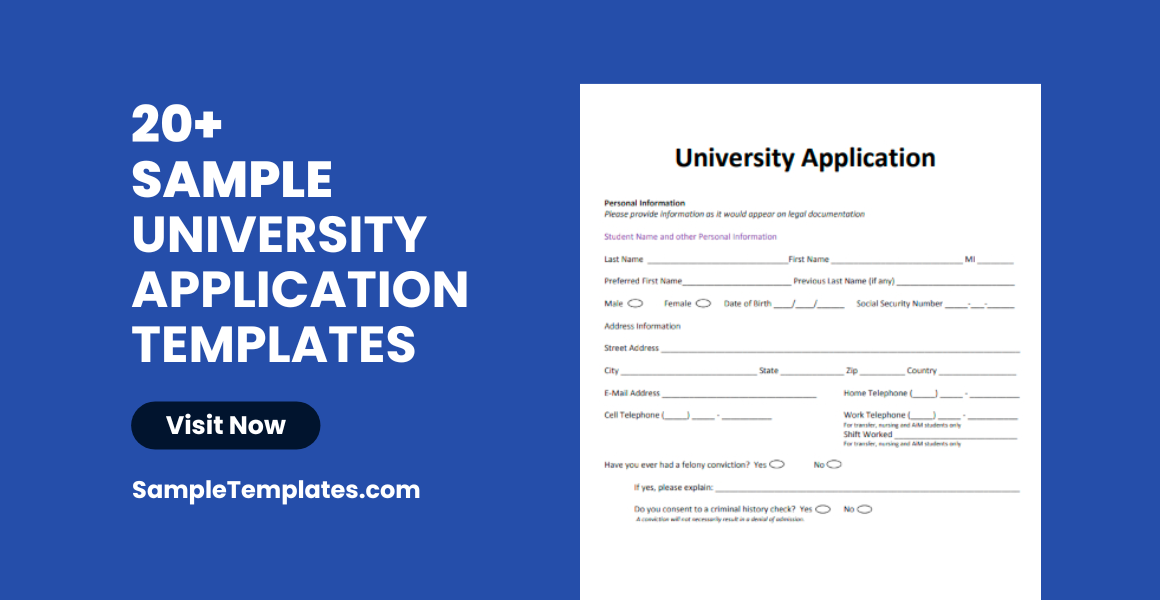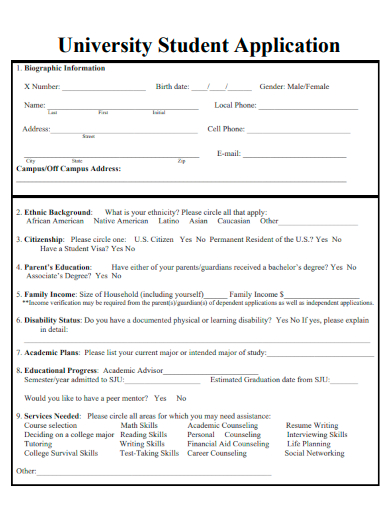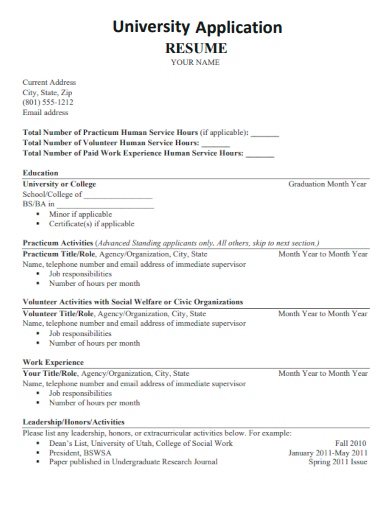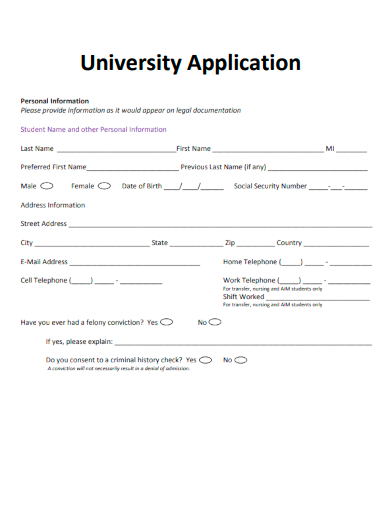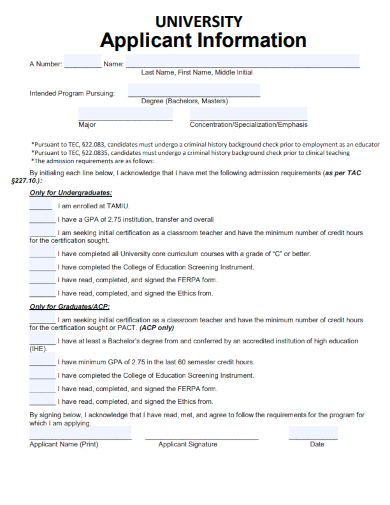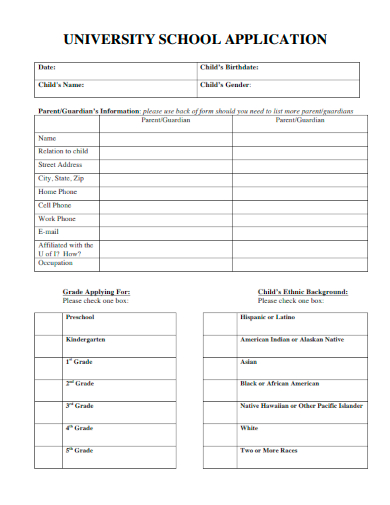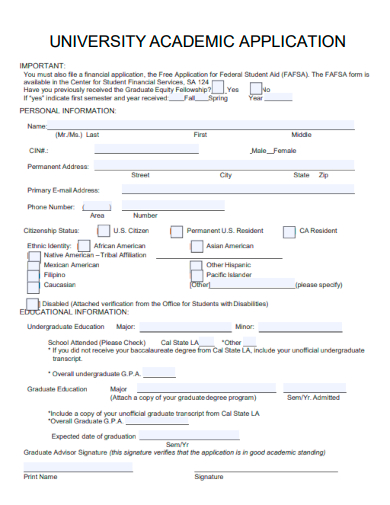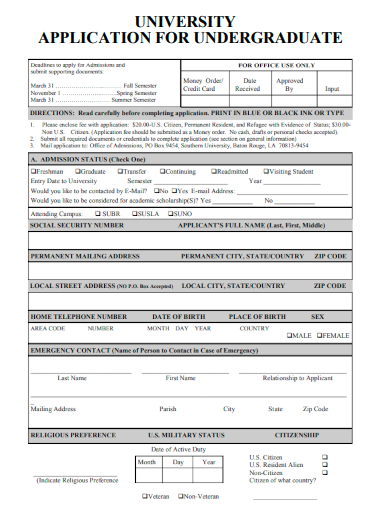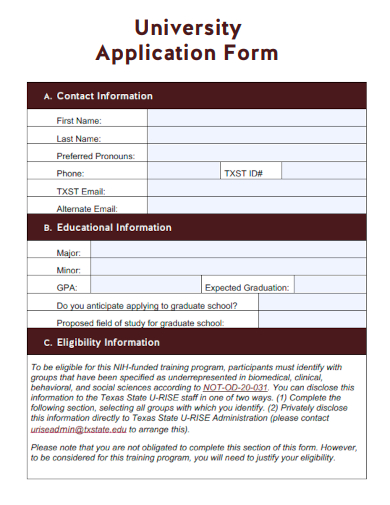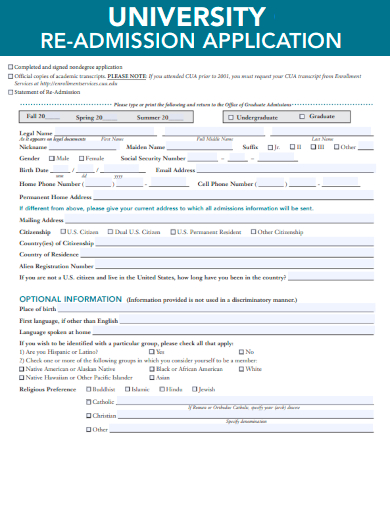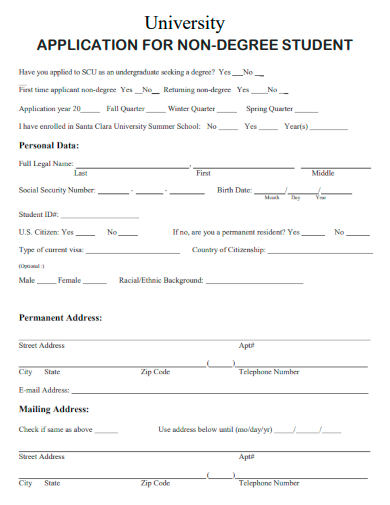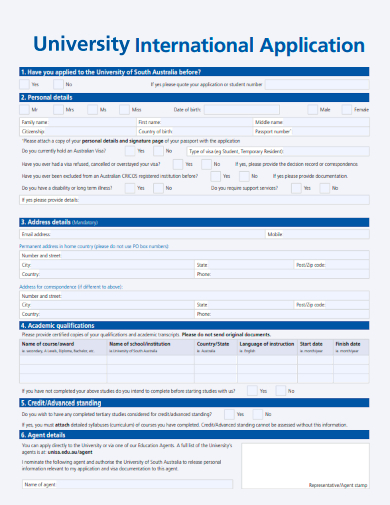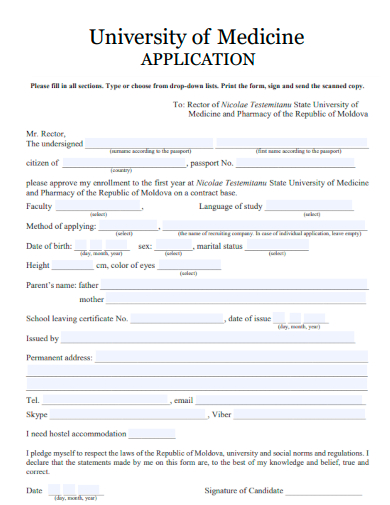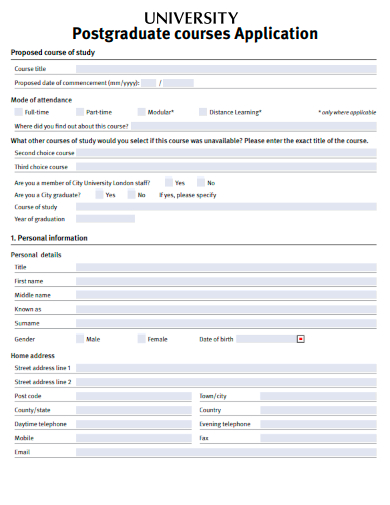In the academic odyssey, the ‘University Application’ stands as a pivotal milestone. This document is more than just paperwork; it embodies aspirations, achievements, and dreams of prospective scholars. Institutions worldwide rely on these format applications to identify the next wave of thinkers, leaders, and innovators. Embark on our comprehensive guide, exploring the nuances, essential components, and the profound impact a compelling University Application has on shaping future academic and career trajectories.
FREE 20+ University Application Samples
1. Sample University Application Letter Template
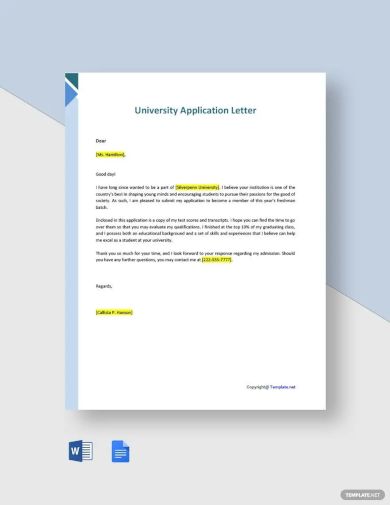
2. Sample University Online Application Template
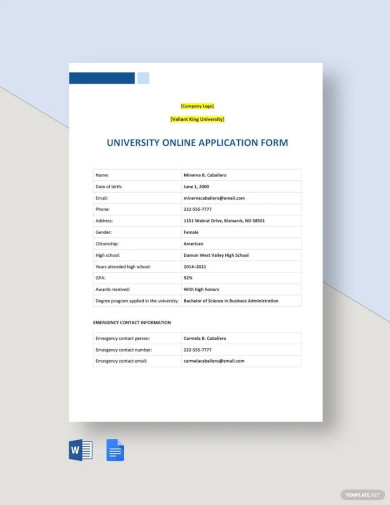
3. Sample University Application Timeline Template
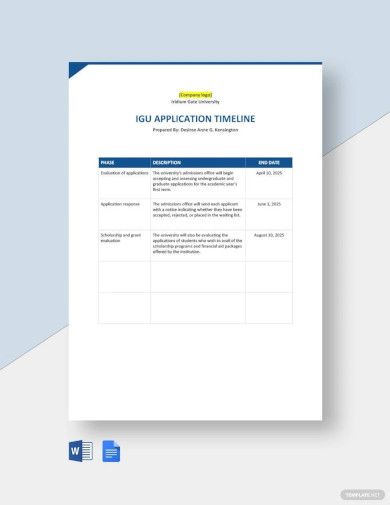
4. Sample University Board Application Template
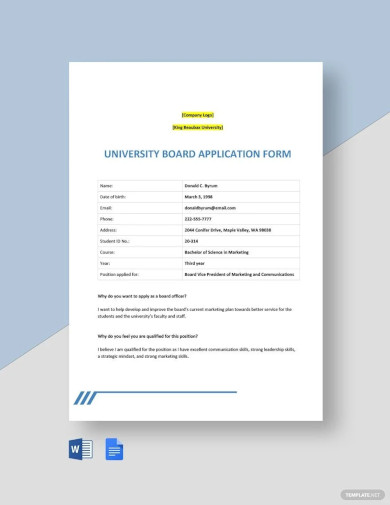
5. Sample University Application Form Template
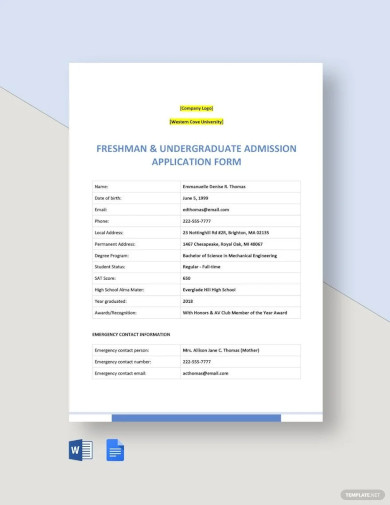
What is a University Application?
Introduction to University Applications
A university application is a digital or sample paper-based document that prospective students fill out to seek admission into a university or college. It serves as a way for educational institutions to gather pertinent information about the applicants, assess their qualifications, and make informed decisions about admissions.
Components of a University Application
- Personal Details: This section usually asks for the applicant’s full name, date of birth, contact information, and sometimes a photograph.
- Academic Records: Details about the applicant’s previous education, including high school or equivalent qualifications, grade point averages, and other relevant scores.
- Statement of Purpose or Personal Essay: A written piece where applicants express their reasons for wanting to attend the university, their future aspirations, and why they believe they would be a good fit.
- Letters of Recommendation: Written endorsements from teachers, mentors, or professionals who can vouch for the applicant’s abilities and character.
- Resume or CV: Some universities request a detailed account of the applicant’s extracurricular activities, work experience, internships, and more.
- Standardized Test Scores: Many universities require scores from tests like the SAT, ACT, GRE, or other relevant exams.
- Portfolio: For courses like art, design, or architecture, a collection of the applicant’s best work might be needed. You can also see more templates like College Application Samples.
The Importance of the University Application Process
The university application is not just a formality. It is the primary tool that universities use to understand who their potential students are. This process allows institutions to curate a diverse and talented student body, which contributes to the overall quality of education and campus life. You can also see more templates like Graduation Application Samples.
The Shift to Digital Applications
With advancements in technology, many universities have shifted from traditional paper-based applications to digital platforms. This transition makes the application writing process more streamlined, environmentally friendly, and convenient for both applicants and the admissions team. Digital applications often come with tools to track the status of the application, receive notifications, and communicate directly with the university.
Tips for a Successful University Application
- Research: Before starting the application, research the university’s requirements, deadlines, and any specific guidelines they have.
- Proofreading: Ensure that the application is free from errors. A well-polished document reflects seriousness and professionalism.
- Honesty: It’s vital to be truthful in your application. Universities value integrity and can usually discern between genuine and exaggerated claims.
- Seek Feedback: Before submitting, it’s a good idea to have a mentor, teacher, or trusted individual sample review the application.
- Stay Organized: Keep track of all the necessary documents, deadlines, and follow-up tasks. This will ensure that nothing is overlooked or submitted late.
Different Types of University Applications
- Undergraduate Applications: Aimed at students fresh out of high school or those with equivalent qualifications.
- Graduate Applications: For those pursuing postgraduate studies, often requiring more detailed academic records and research proposals.
- International Student Applications: Tailored for students applying from abroad, often including sections on language proficiency and visa information.
- Transfer Applications: For students who have started their university education elsewhere and are seeking to transfer.
- Specialized Course Applications: Some specialized courses or disciplines might have their specific application forms, such as performing arts or advanced research programs.
The Role of Digital Platforms in University Applications
- Environmentally Friendly: Reduces the need for paper and printing.
- Ease of Access: Can be accessed from anywhere, anytime, making it convenient for international students.
- Integrated Systems: Many digital platforms now integrate with other systems, allowing for automatic retrieval of test scores, past academic records, etc.
- Real-time Updates: Applicants can receive real-time notifications about the status of their application, upcoming interviews, or required process documentation.
Common Challenges Faced by Applicants
- Navigating Different Requirements: Different universities, and often different courses within the same university, have varying requirements. Keeping track can be overwhelming.
- Financial Constraints: Application fees, especially for top-tier universities, can be a burden for some students.
- Meeting Deadlines: Especially for students juggling school, extracurriculars, and possibly even part-time jobs, meeting application deadlines can be a challenge.
- Cultural Barriers: International students might find some application questions to be unfamiliar or challenging due to cultural differences.
How to Stand Out in Your University Application
- Tailor Your Application: Avoid generic statements. Tailor your application to show why you’re a good fit for that specific university or course.
- Highlight Unique Experiences: Maybe you’ve undertaken a unique project, had a relevant job, or traveled extensively. Use these experiences to your advantage.
- Engage in Extracurricular Activities: Universities appreciate well-rounded individuals. Participate in clubs, sports, or community service to showcase a diverse set of skills and interests. You can also see more templates like General Application Form Samples.
How to Fill a University Application?
Filling out a university application can be both an exciting and nerve-wracking experience. It’s your opportunity to showcase your achievements, aspirations, and personality to your chosen institution. This guide provides step-by-step instructions to ensure that you complete your application accurately and present yourself in the best possible light.
1. Understand the Requirements
- Research the Specifics: Different universities, and even different programs within those universities, have unique application requirements. Make sure you’re familiar with these specifics before starting.
- Gather Necessary Documents: This might include transcripts, test scores, identification documents, and more. Having everything at hand will make the process smoother.
2. Personal and Contact Information
- Accuracy is Key: Ensure that your name, address, date of birth, and other personal details are accurate and consistent with other official documents.
- Provide a Professional Email Address: Avoid using casual or outdated email addresses. Consider creating a new one if necessary, preferably with your full name.
3. Academic History
- Transcripts and Grades: You’ll likely need to provide details of your previous education, including institutions attended, courses studied, and grades achieved.
- Standardized Test Scores: If applicable, enter scores from tests like the SAT, ACT, GRE, or other relevant exams. Some universities might require you to send scores directly from the testing agency.
4. Statement of Purpose or Personal Essay
- Be Authentic: This is your chance to showcase who you are, why you want to study your chosen course, and what your future aspirations are. Avoid generic statements and tailor your essay to the specific university and program.
- Proofread: Ensure your essay is free from errors and is well-structured. Consider seeking sample feedback from teachers, mentors, or trusted peers.
5. Letters of Recommendation
- Choose Wisely: Select individuals who know you well and can vouch for your academic and personal qualities. This might include teachers, coaches, employers, or mentors.
- Give Them Time: Approach your recommenders well in advance. This gives them ample time to write a thoughtful letter.
6. Additional Documents
- Resumes and CVs: Detail your extracurricular activities, leadership roles, work experience, and other achievements.
- Portfolios: For courses like art, design, or architecture, you’ll need to provide samples of your work.
7. Financial Information
If you’re applying for financial aid or scholarships, you might need to:
- Submit Financial Documents: This could include tax returns, salary slips, or bank statements.
- Complete Additional Forms: Some universities have their own financial aid sample forms, while others might use standard ones like the FAFSA.
8. Review and Submit
- Double-Check Everything: Before hitting the submit button, go through your application thoroughly. Ensure all details are accurate and all required documents are attached.
- Keep Copies: Save or print a copy of your completed application for reference.
- Track Your Application: Most digital platforms allow you to track the status of your application. Regularly check for any updates or additional requirements.
6. Sample University Student Application Template
7. Sample University Resume Application Template
8. Sample University Admission Application Template
9. Sample University Blank Application Template
10. Sample University Application Information Template
11. Sample University School Application Template
12. Sample University Academic Application Template
13. Sample University Writing Application Template
14. Sample University Application for Undergraduate Template
15. Sample University Application Processing Template
16. Sample University Application Form Example
17. Sample University Re-Admission Application Template
18. Sample University Application for Non-Degree Student Template
19. Sample University International Application Template
20. Sample University of Medicine Application Template
21. Sample University Postgraduate Courses Application Template
How do you Create a University Application?
Creating a university application requires a methodical approach to gather all necessary information from prospective students. Here’s a detailed guide on creating a university application in five comprehensive steps:
Step 1: Personal Details & Contact Information
Start with the basics. The professional form should request the applicant’s full name, date of birth, gender, nationality, and permanent address. Additionally, ask for contact details like a phone number, email address, and alternative contact details, if any. It’s essential that the university has multiple ways to get in touch with applicants, especially for international students where time zones may vary.
Step 2: Academic Background & Transcripts
This section is crucial. Prospective students should list all their previous educational institutions, beginning from high school onwards. The application should also require applicants to attach or send official transcripts, sample certificates, and any standardized test scores (e.g., SAT, ACT, GRE, GMAT, etc.). Some universities may also request a detailed breakdown of subjects taken and grades received during their last years of schooling. Ensure there’s a system in place for verifying these documents.
Step 3: Extracurricular Activities & Achievements
While academic prowess is vital, universities often seek well-rounded individuals. This section should provide space for students to list extracurricular activities, such as sports, arts, clubs, volunteer work, internships, and any leadership roles they’ve taken on. Additionally, there should be room to mention any notable achievements, sample awards, or recognitions they’ve received over the years. This paints a fuller picture of the applicant beyond just grades and test scores.
Step 4: Personal Statement & Recommendations
Most universities require a personal statement or essay. This provides insight into the student’s motivations, aspirations, and why they’re choosing that particular university or course. Provide guidelines on length and potential topics. Additionally, request letters of recommendation. These should ideally come from teachers, counselors, or professionals who can vouch for the student’s abilities, character, and potential. Clearly indicate how many letters are required and provide a mechanism for these to be sent, whether attached to the application or sent directly by the recommenders.
Step 5: Application Fee & Submission Details
Almost all universities charge an application fee. Clearly mention the fee amount and provide a secure method for payment, such as credit card processing or bank transfers. Ensure there’s a system in place for sending a confirmation sample receipt to the applicant. Finally, provide comprehensive submission guidelines. This includes deadlines, the method of submission (online portal, email, postal mail), and what happens next in the process. Inform students about interview rounds, potential entrance exams, or any additional steps required.
In Conclusion, a university application is more than just a form; it’s a representation of a student’s academic journey, aspirations, and potential. As universities continue to evolve in the digital age, the application process will likely see further innovations, making it even more user-friendly and efficient. However, the core components that make an application stand out—authenticity, preparation, and thoroughness—remain timeless.
Related Posts
FREE 16+ Master Application Samples in MS Word | PDF
FREE 20+ Sample High School Application Form Templates in PDF
FREE 17+ Referral Application Samples in MS Word | PDF
FREE 14+ Admission Application Samples in MS Word | Apple Pages | PDF
FREE 29+ Student Application Form Samples in PDF | MS Word
FREE 21+ Administrative Application Samples in MS Word | Apple Pages | PDF
FREE 21+ Teacher Application Samples in MS Word | Apple Pages | Outlook | PDF
FREE 25+ Transfer Application Samples in MS Word | Apple Pages | PDF
FREE 23+ Participation Application Samples in MS Word | PDF
FREE 14+ Patient Application Samples in MS Word | PDF
FREE 21+ Eligibility Application Samples in PDF
FREE 20+ Travel Application Samples in PDF | MS Word
FREE 23+ Candidate Application Samples in PDF
FREE 33+ Committee Application Samples in PDF | MS Word
FREE 37+ Supplemental Application Samples in PDF | MS Word
